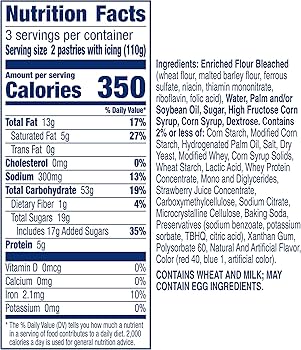
Toaster Strudels are a beloved breakfast treat, known for their convenient preparation and satisfyingly sweet flavor. However, when it comes to nutrition, these pastries often raise eyebrows. While undeniably delicious, they’re typically high in sugar, refined carbohydrates, and unhealthy fats, which can impact your overall health if consumed regularly. This article delves into the nutritional aspects of Toaster Strudels, exploring their sugar content, potential downsides, and tips for making healthier choices when indulging in this popular pastry.
This comprehensive guide will break down the nutritional profile of Toaster Strudels, examining their sugar content, fat composition, and overall calorie count. We’ll also discuss the potential health implications of frequent consumption and offer practical strategies for enjoying Toaster Strudels in moderation while prioritizing your well-being.
Toaster Strudels Nutrition Facts
A single serving of Toaster Strudels typically contains around 200 calories, with varying amounts of fat, carbohydrates, and protein depending on the flavor. While they provide a small amount of fiber, their nutritional value is primarily driven by their high sugar content and refined grains.
The majority of calories in Toaster Strudels come from carbohydrates, largely in the form of refined flour and added sugars. This lack of complex carbohydrates means they offer limited sustained energy and can contribute to blood sugar spikes and crashes.
Furthermore, Toaster Strudels often contain trans fats, which are known to raise bad cholesterol levels and increase the risk of heart disease. While some manufacturers have reduced or eliminated trans fats in their recipes, it’s essential to check the nutrition label carefully before purchasing.
Sugar Content in Toaster Strudels

One of the most significant nutritional concerns with Toaster Strudels is their high sugar content. A single serving can contain upwards of 10 grams of added sugars, which contribute significantly to their overall calorie count and lack of nutritional value.
Consuming excessive amounts of added sugars has been linked to various health problems, including weight gain, type 2 diabetes, heart disease, and tooth decay. It’s important to be mindful of your sugar intake and choose breakfast options that are lower in added sugars for better overall health.
Healthy Eating Tips for Toaster Strudels
While Toaster Strudels shouldn’t be a staple in a healthy diet, there are ways to enjoy them occasionally without compromising your well-being.
Moderation is Key: Limit your intake of Toaster Strudels to one serving per week or less. This helps prevent excessive sugar and calorie consumption.
Pair with Protein and Fiber: To balance out the sugar content, combine your Toaster Strudel with a source of protein and fiber. A glass of milk, yogurt, or a handful of nuts can help stabilize blood sugar levels and promote satiety.
Choose Whole-Grain Options: Opt for whole-grain Toaster Strudels whenever possible. They contain more fiber and nutrients compared to their refined-grain counterparts.
Whole-Grain Toaster Strudel Options

Fortunately, some manufacturers offer whole-grain varieties of Toaster Strudels, providing a slightly healthier alternative. These options typically contain more fiber and complex carbohydrates, contributing to better blood sugar control and sustained energy levels.
When choosing whole-grain Toaster Strudels, look for products that list “whole wheat flour” or “whole grain oats” as the first ingredient. Be sure to check the nutrition label to compare sugar content and other nutritional values between different brands and flavors.
Conclusion
Toaster Strudels can be a tempting treat, but their high sugar content and refined ingredients make them less than ideal for regular consumption. By understanding their nutritional profile and practicing moderation, you can enjoy these pastries occasionally without compromising your health goals. Opting for whole-grain varieties and pairing them with protein and fiber can help mitigate some of the downsides. Remember, a balanced diet rich in fruits, vegetables, whole grains, and lean proteins is essential for overall well-being.
